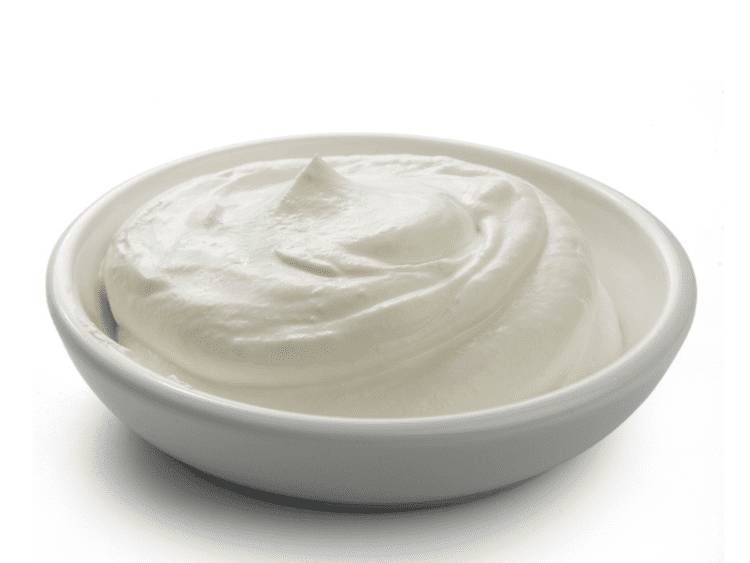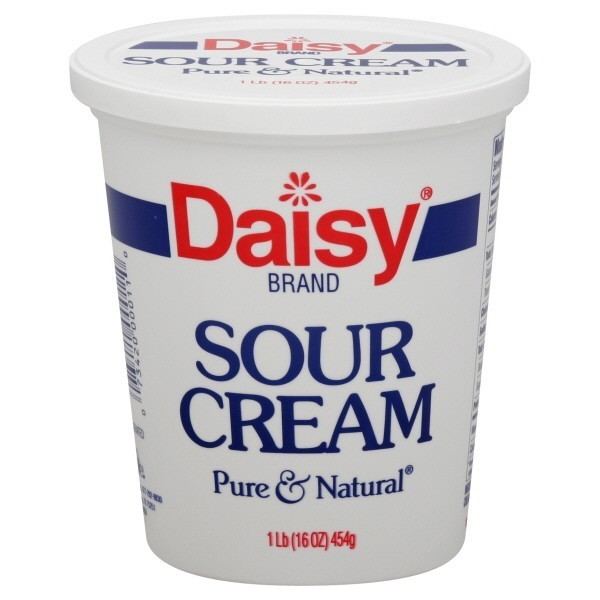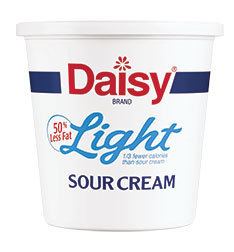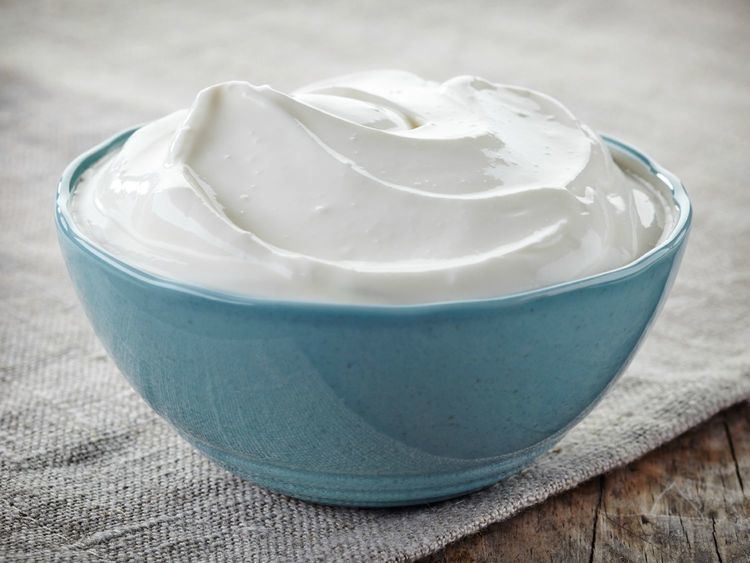 | ||
Similar Guacamole, Cheddar cheese, Salsa, Onion, Wheat tortilla | ||
How to make sour cream gemma s bold baking basics ep 21
Sour cream is a dairy product obtained by fermenting regular cream with certain kinds of lactic acid bacteria. The bacterial culture, which is introduced either deliberately or naturally, sours and thickens the cream. Its name comes from the production of lactic acid by bacterial fermentation, which is called souring.
Contents
- How to make sour cream gemma s bold baking basics ep 21
- Sour cream sanjeev kapoor khazana
- Traditional
- Commercial varieties
- Ingredients
- Protein Composition
- Processing
- Physical Chemical Changes
- Rheological Properties
- Uses
- References

Sour cream sanjeev kapoor khazana
Traditional

Traditionally, sour cream was made by letting cream that was skimmed off the top of milk ferment at a moderate temperature. The bacteria that developed during fermentation thickened the cream and made it more acidic, a natural way of preserving it.

Traditional sour cream contains from 18 to 20 percent butterfat and gets its characteristic tang from the lactic acid created by the bacteria.
Commercial varieties
Commercially produced sour cream usually contains 14 percent milk fat, and can contain additional thickening agents such as gelatin, rennet, guar gum and carrageenan, as well as acids to artificially sour the product.
Light, or reduced-fat, sour cream contains less butterfat than regular sour cream, because it is made from a mixture of milk and cream rather than just cream. Fat-free "sour cream" contains no cream at all, and is made primarily from non-fat milk, modified cornstarch, thickeners and flavoring agents.
Sour cream is not fully fermented, and like many dairy products, must be refrigerated unopened and after use. It is sold with an expiration date stamped on the container, though whether this is a "sell by", a "best by" or a "use by" date varies with local regulation. Refrigerated unopened sour cream can last for 1–2 weeks beyond its sell by date while refrigerated opened sour cream generally lasts for 7–10 days.
Ingredients
Cultured cream.
Processed sour cream can include the any of the following additives and preservatives: grade A whey, modified food starch, sodium phosphate, sodium citrate, guar gum, carrageenan, calcium sulfate, potassium sorbate, and locust bean gum.
Protein Composition
Milk is approximately made up of 3.0-3.5% proteins,the main proteins in cream are caseins and whey proteins, caseins are globular proteins with phosphoserine residue. Of the total fraction of milk proteins caseins make up 80% of the fraction while the whey protein make up 20% of the total fraction of proteins. There are four main classes of caseins; β-caseins, α(s1)-caseins, α(s2)-casein and κ-caseins. These casein proteins form a multi molecular colloidal particle known as a casein micelle. The proteins mention have an affinity to bind with other casein proteins, or to bind with calcium phosphate, this binding is what forms the aggregates. The casein micelle are the aggregates of β-caseins, α(s1)-caseins, α(s2)-caseins, that are coated with κ-caseins. The proteins are held together by small clusters of calcium phosphate, the micelle also contains lipase, citrate, minor ions, and plasmin enzymes, along with entrapped milk serum. Casein micelles are rather porous structures, ranging in the size of 50-250 nm in diameter and the structures on average are 6-12% of the total volume fraction of milk. The structure is porous in order to be able to hold a sufficient amount of water, it structure also assists in the reactivity of the micelle. The formation of casein molecules into the micelle is very unusual due to β-caseins large amount of propyl residues (the proline residues disrupt the formation of α-helical and β-sheet ) and because κ-caseins only contain one phosphorylation residue (they are glycoproteins). Due to κ-caseins being glycoproteins, they are stable in the presence of calcium ions so the κ-caseins are on the outer layer of the micelle to partially protect the non glycoproteins β-caseins, α(s1)-caseins, α(s2)-caseins from precipitating out in the presence of excess calcium ions. Casein micelles are not heat sensitive particles, they are pH sensitive. The colloidal particles are stable at the normal pH of milk which is 6.5-6.7, the micelles will precipitate at the isoelectric point of milk which is a pH of 4.6.
The proteins that make up the remaining 20% of the fraction of proteins in cream are known as whey proteins. Whey proteins are also widely referred to as serum proteins, which is used when the casein proteins have been precipitated out of solution. The two main components of whey proteins in milk are β-lactoglobulin and α-lactalbumin. The remaining whey proteins in milk are; immunoglobulins, bovine serum albumin, and enzymes such as lysozyme. Whey proteins are much more water-soluble than casein proteins. The main biological function of β-lactoglobulin in milk is to serve as a way to transfer vitamin A, and the main biological function of α-lactalbumin in lactose synthesis. The whey proteins are very resistant against acids and proteolytic enzymes. However whey proteins are heat sensitive proteins, the heating of milk will cause the denaturation of the whey proteins. The denaturation of these proteins happens in two steps. The structures of β-lactoglobulin and α-lactalbumin unfold, and then the second step is the aggregation of the proteins within milk. This is one of the main factors that allows whey proteins to have such good emulsifying properties. Native whey proteins are also known for their good whupping properties, and in milk products as described above their gelling properties. Upon denaturation of whey proteins, there is an increase in the water holding capacity of the product.
Processing
Sour cream, or cultured cream, is manufactured through the processing of cream, and the addition of lactic acid bacteria. Cream is prepared from milk, in today’s industry by centrifugal separation. Cream is high in fat, the variety of cream that is used in sour cream production is coffee cream which is 18% milk fat. Once the cream is separated from the milk, the milk fat is distributed in the manner of an oil-in-water emulsion. Another example of an oil-in-water emulsion is mayonnaise.
The manufacturing of cultured cream begins with the standardization of fat content, this step is to ensure that the desired or legal amount of milk fat is present in the food system. As previously mentioned the minimum amount of milk fat that must be present in sour cream is 18%. During this step in the manufacturing process other dry ingredients are added with the cream, additional grade A whey for example would be added at this time. Another type of dry product that is added during this processing step are a series of ingredients known as stabilizers. The common stabilizers that are added to sour cream are polysaccharides and gelatin. Recall the ingredients in sour cream include the following components that act as stabilizers; modified food starch, guar gum, and carrageenans. The reasoning behind the addition of stabilizers to fermented dairy products (sour cream, yoghurt, etc.) is provide smoothness in the body and texture of the product. The stabilizers also assist in the gel structure of the product and reduce whey syneresis. The formation of these gels structures, leaves less free water for whey syneresis, therefore extending the shelf life. Whey syneresis is the loss of moisture by the expulsion of whey. This expulsion of whey can occur during the transportation of containers holding the sour cream, due to the susceptibility to motion and agitation. The next step in the manufacturing process is the acidification of the cream. Organic acids such as citric acid or sodium citrate are added to the cream prior to homogenization in order to increase the metabolic activity of the starter culture. To prepare the mixture for homogenization, it is heated for a short period of time.
Homogenization is a processing method that is utilized to improve the quality of the sour cream in regards to the color, consistency, creaming stability, and creaminess of the cultured cream. During homogenization larger fat globules within the cream are broken down into smaller sized globules to allow an even suspension within the system. At this point in the processing the milk fat globules and the casein proteins are not interacting with each other, there is repulsion occurring. The mixture is homogenized, under high pressure homogenization above 130 bar (unit) and at a high temperature of 60 °C. The formation of the small globules (below 2 microns in size) previously mentioned allows for reducing a cream layer formation and increases the viscosity of the product. There is also a reduction in the separation of whey, enhancing the white color of the sour cream.
After homogenization of the cream, the mixture must undergo pasteurization. Pasteurization is a mild heat treatment of the cream, with the purpose of killing any harmful bacteria in the cream. The homogenized cream undergoes high temperature short time (HTST) pasteurization method. In this type of pasteurization the cream is heated to the high temperature of 85 °C for thirty minutes. This processing step allows for the a sterile medium for when it is time to introduce the starter bacteria.
After the process of pasteurization, there is a cooling process where the mixture is cooled down to a temperature of 20˚C. The reason that the mixture was cooled down to the temperature of 20˚C is due to the fact that this is an ideal temperature for mesophilic inoculation. After the homogenized cream has been cooled to 20˚C, it is inoculated with 1-2% active starter culture. The type of starter culture utilized is essential for the production of sour cream. The starter culture is responsible for initiating the fermentation process by enabling the homogenized cream to reach the pH of 4.5 to 4.8. Lactic acid bacteria (hereto known as LAB) ferment lactose to lactic acid, they are Gram-positive facultative anaerobes. The strains of LAB that are utilized to allow the fermentation of sour cream production are Lactococcus lactis subsp latic or Lactococcus lactis subsp cremoris they are lactic acid bacteria associated with producing the acid. The LAB that are known for producing the aromas in sour cream are Lactococcus lactis ssp. lactis biovar diacetyllactis. Together these bacteria produce compounds that will lower the pH of the mixture, and produce flavor compounds such as diacetyl.
After the inoculation of starter culture, the cream is portioned in packages. For 18 hours a fermentation process takes place in which the pH is lowered from 6.5 to 4.6. After fermentation, one more cooling process takes place. After this cooling process the sour cream is packaged into their final containers and sent to the market.
Physical-Chemical Changes
After the processing step homogenization there was an increase in surface area of the fat globules due to being broken down into smaller particles. During the pasteurization process temperatures were raised past the point where all the particles in the system are stable. When cream is heated to temperatures above 70°C, there is denaturation of whey proteins. When the whey protein, β-lactoglobulin denatures, it will complex with the surfaces of casein micelles and fat globules. To avoid phase separation, brought on by the increased surface area, the fat globules readily bind with the denatured β-lactoglobulin. The absorption of the denatured whey proteins (and whey proteins that bound with casein micelles) increases the number of structural components in the system; this is attributed with the texture of sour cream. The denaturation of whey proteins is also known for increasing the strength of the cross-linking within the cream system, due to the formation of whey protein polymers.
When the cream is inoculated with starter bacteria and the bacteria begins converting lactose to lactic acid, the pH begins a slow decrease. When this decrease begins, dissolution of calcium phosphate occurs, and causes a rapid drop in the pH. During the processing step fermentation the pH was dropped from 6.5 to 4.6, this drop in pH brings on a physicochemical change to the casein micelles. Recall the casein proteins are heat stable, but they are not stable in certain acidic conditions. The colloidal particles are stable at the normal pH of milk which is 6.5-6.7, the micelles will precipitate at the isoelectric point of milk which is a pH of 4.6. At a pH of 6.5 the casein micelles repulse each other due to the electronegativity of the outer layer of the micelle. During this drop in pH there is a reduction in zeta potential, from the highly net negative charges in cream to no net charge when approaching the PI.
Rheological Properties
Sour cream exhibits time-dependent thixotropic behaviors. Thixotropic fluids reduce in viscosity as work is applied and when the product is no longer under stress, the fluid returns to its previous viscosity. The viscosity of sour cream at room temperature is 100,000 cP, (for comparison: water has a viscosity of 1 cP at 20 °C). The thixotropic properties exhibited by sour cream are what make it such a versatile product in the food industry.
Uses
Sour cream is used primarily in the cuisines of Europe and North America, often as a condiment. It is a traditional topping for baked potatoes, added cold along with chopped fresh chives. It is used as the base for some creamy salad dressings and can also be used in baking, added to the mix for cakes, cookies, American-style biscuits, doughnuts and scones. It can be eaten as a dessert, with fruits or berries and sugar topping. Also, it is sometimes used on top of waffles in addition to strawberry jam. In Central America, crema (a variation of sour cream) is a staple ingredient of a full breakfast.
Sour cream can also provide the base for various forms of dip used for dipping potato chips or crackers, such as onion dip.
In Tex-Mex cuisine, it is often used as a substitute for crema in nachos, tacos, burritos, taquitos or guacamole.
Sour cream is one of the main ingredients in chicken paprikash and beef Stroganoff. It is also the main ingredient in the traditional Norwegian porridge Rømmegrøt which is named after the cream.
A variation of sour cream known as smetana is also popular in eastern Europe and Russia as soup condiment, usually added to individual bowls and stirred until dissolved.
